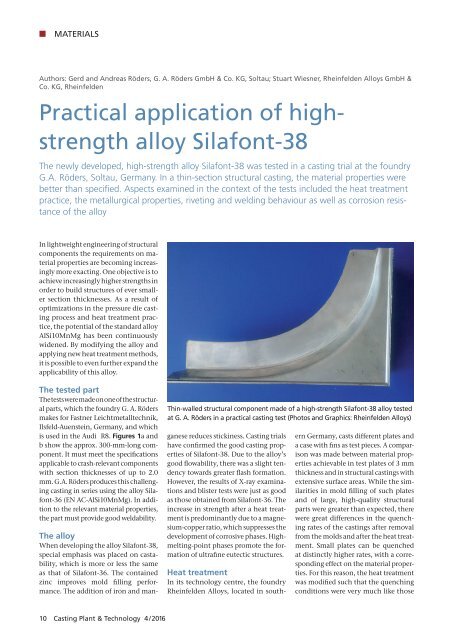CPT International 04/2016
The leading technical journal for the global foundry industry – Das führende Fachmagazin für die weltweite Gießerei-Industrie
The leading technical journal for the
global foundry industry – Das führende Fachmagazin für die
weltweite Gießerei-Industrie
You also want an ePaper? Increase the reach of your titles
YUMPU automatically turns print PDFs into web optimized ePapers that Google loves.
K MATERIALS<br />
Authors: Gerd and Andreas Röders, G. A. Röders GmbH & Co. KG, Soltau; Stuart Wiesner, Rheinfelden Alloys GmbH &<br />
Co. KG, Rheinfelden<br />
Practical application of highstrength<br />
alloy Silafont-38<br />
The newly developed, high-strength alloy Silafont-38 was tested in a casting trial at the foundry<br />
G.A. Röders, Soltau, Germany. In a thin-section structural casting, the material properties were<br />
better than specified. Aspects examined in the context of the tests included the heat treatment<br />
practice, the metallurgical properties, riveting and welding behaviour as well as corrosion resistance<br />
of the alloy<br />
In lightweight engineering of structural<br />
components the requirements on material<br />
properties are becoming increasingly<br />
more exacting. One objective is to<br />
achieve increasingly higher strengths in<br />
order to build structures of ever smaller<br />
section thicknesses. As a result of<br />
optimizations in the pressure die casting<br />
process and heat treatment practice,<br />
the potential of the standard alloy<br />
AlSi10MnMg has been continuously<br />
widened. By modifying the alloy and<br />
applying new heat treatment methods,<br />
it is possible to even further expand the<br />
applicability of this alloy.<br />
The tested part<br />
The tests were made on one of the structural<br />
parts, which the foundry G. A. Röders<br />
makes for Fastner Leicht metalltechnik,<br />
Ilsfeld-Auenstein, Ger many, and which<br />
is used in the Audi R8. Figures 1a and<br />
b show the approx. 300-mm-long component.<br />
It must meet the specifications<br />
applicable to crash-relevant components<br />
with section thicknesses of up to 2.0<br />
mm. G.A. Röders produces this challenging<br />
casting in series using the alloy Silafont-36<br />
(EN AC-AlSi10MnMg). In addition<br />
to the relevant material properties,<br />
the part must provide good weldability.<br />
Thin-walled structural component made of a high-strength Silafont-38 alloy tested<br />
at G. A. Röders in a practical casting test (Photos and Graphics: Rheinfelden Alloys)<br />
The alloy<br />
When developing the alloy Silafont-38,<br />
special emphasis was placed on castability,<br />
which is more or less the same<br />
as that of Silafont-36. The contained<br />
zinc improves mold filling performance.<br />
The addition of iron and manganese<br />
reduces stickiness. Casting trials<br />
have confirmed the good casting properties<br />
of Silafont-38. Due to the alloy’s<br />
good flowability, there was a slight tendency<br />
towards greater flash formation.<br />
However, the results of X-ray examinations<br />
and blister tests were just as good<br />
as those obtained from Silafont-36. The<br />
increase in strength after a heat treatment<br />
is predominantly due to a magnesium-copper<br />
ratio, which suppresses the<br />
development of corrosive phases. Highmelting-point<br />
phases promote the formation<br />
of ultrafine eutectic structures.<br />
Heat treatment<br />
In its technology centre, the foundry<br />
Rheinfelden Alloys, located in southern<br />
Germany, casts different plates and<br />
a case with fins as test pieces. A comparison<br />
was made between material properties<br />
achievable in test plates of 3 mm<br />
thickness and in structural castings with<br />
extensive surface areas. While the similarities<br />
in mold filling of such plates<br />
and of large, high-quality structural<br />
parts were greater than expected, there<br />
were great differences in the quenching<br />
rates of the castings after removal<br />
from the molds and after the heat treatment.<br />
Small plates can be quenched<br />
at distinctly higher rates, with a corresponding<br />
effect on the material properties.<br />
For this reason, the heat treatment<br />
was modified such that the quenching<br />
conditions were very much like those<br />
10 Casting Plant & Technology 4 / <strong>2016</strong>


















